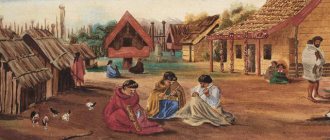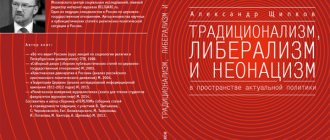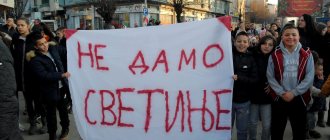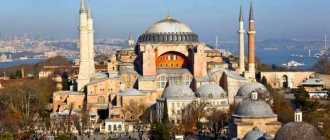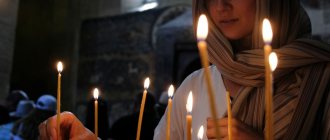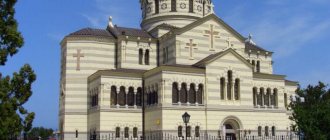Wikipedia has articles about other people named Sylvester.
Sylvester
(in monks
Spiridon
, died about 1566) - Russian Orthodox priest, political and literary figure of the 16th century.
He began his spiritual career in Novgorod, then became a priest of the Annunciation Cathedral in the Moscow Kremlin. He was associated with Metropolitan Macarius.
During the Moscow fire and uprising in 1547, he made an accusatory speech against the young Ivan IV (the Terrible), which was received favorably and made Sylvester close to the king.
Together with A.F. Adashev, Sylvester was the foremost leader of the “Chosen Rada”. In 1553, during the Tsar's serious illness, Sylvester was close to the Tsar's cousin, Prince Vladimir Staritsky, who laid claim to the throne. Upon recovery, the Tsar lost interest in Sylvester, and in 1560, after rumors appeared about his involvement in the death of Queen Anastasia, he exiled him to the Kirilo-Belozersky Monastery, and from there to the Solovetsky Monastery, where he took monastic vows. He spent the rest of his life in northern monasteries, professing the philosophy of non-covetousness.
Literature
- Ivanitsky V.
Russian woman in the era of “Domostroy” // Social sciences and modernity. 1995. No. 3. - P. 161-172. - Usachev A. S.
Sylvester and the life of Princess Olga // Rumyantsev Readings 2009. Historical and cultural traditions and innovative transformations in Russia. Educational responsibility of libraries. Part 1: materials of the international scientific conference (April 21-23, 2009). - M., 2009. - P. 246-254. - Usachev A.S.
Personality of the compiler of the Degree Book // Ancient Russia. Questions of medieval studies. 2009. No. 2 (36). — P. 34-47
SYLVESTER
SYLVESTER (late 15th century or early 16th century, Novgorod, now Vel. Novgorod - between 1574/75 and 1577, Kirillo-Belozersky Monastery), Russian. church leader and writer, priest of the Annunciation Cathedral of the Moscow Kremlin (no later than 1545/46 - ca. 1560). In Novgorod he had a workshop specializing in book and icon work, jewelry production, and trade. Since the 1540s in Moscow, entered the inner circle of Tsar Ivan IV Vasilyevich the Terrible. After the fire in the Moscow Kremlin in 1547, the headman was appointed to oversee the correct restoration of paintings in Kremlin churches. Perhaps he was the king's second confessor. Member of the “Elected Rada”. Political S.'s position and role at court are the subject of debate in historiography, which is explained by the extreme paucity of biographical records. data. Submitted to the church council of 1553–54 a “Complaint” against I.M. Viskovaty, who accused S. (on the basis of the painted paintings of the temples of the Moscow Kremlin) of deviating into heresy. In Aug. 1560 or a little later he left Moscow and accepted the monastery in Kirillo-Belozersky. tonsured with the name Spiridon.
He owned an extensive library, the replenishment of which was facilitated by S.’s strong connections in the church-political environment. elite, and also, possibly, his contacts with the metropolitan and royal libraries. Among other things, S. kept manuscripts of Maxim the Greek (they moved to the Kirillo-Belozersky Monastery). As a priest of the Annunciation Cathedral in the Moscow Kremlin, S. received some books intended for the Tsar. While in Moscow, S. made contributions (including books) to the Alexander Hermitage (with his son Anfim, 1545/46), Solovetsky Monastery. (together with his son in 1551/52; 1552; not earlier than 1566 - 66 books; in 1574/75 - for the frame of an icon or Gospel), Chudov mon. (1555/56), perhaps also sent contributions to Athos (at least the Explanatory Psalter, which belonged to S., is known in the library of the Hilandar monastery). Most of the S. library ended up in the Kirillo-Belozersky monastery.
It can be said with complete confidence that S. was the author of two works: Message to the Kazan governor, Prince. A. B. Gorbatom (1553) and Messages and punishments from father to son Anfim [2nd half. 1550s; Chapter 64 of the 2nd (lengthy) edition of Domostroi]. With a certain degree of probability, S. is also attributed to an anonymous message to the king and an anonymous message to a certain nobleman, contained in the same collection with the message of the prince. Hunchback. According to a number of researchers, the message to Ivan IV served as one of the sources of Stoglav, which became the result of the work of the Stoglavy Council (1551). The messages testify that their author was well versed in the Holy Scriptures, knew the history of Byzantium and the Ancient World, and used the text of the Epistle to the Ugra by Archbishop. Rostov Vassian Snout. S.’s role in the compilation of “Domostroi” is controversially assessed by researchers (S. was simply a copyist; S. was the editor of an older text; S. was the sole author of the text). In relation to a number of other works (including the Life of Princess Olga for the “Degree Book”), hypotheses about S.’s authorship are generally not solid.
Links
- Sylvester, priest of the Annunciation Cathedral // Encyclopedic Dictionary of Brockhaus and Efron: in 86 volumes (82 volumes and 4 additional). - St. Petersburg, 1890-1907.
- D. M. Bulanin, V. V. Kolesov.
[www.pushkinskijdom.ru/Default.aspx?tabid=4591 Sylvester, priest of the Annunciation Cathedral] // Publications of the Institute of Literary Literature of the Russian Academy of Sciences - N. Pushkareva.
[www.krugosvet.ru/enc/istoriya/SILVESTR.html Sylvester] // Encyclopedia “Round the World”. - [www.rusk.ru/st.php?idar=800875 Son of the priest Sylvester]
- [nesusvet.narod.ru/books/domostroy.htm Domostroy, Silvestrov edition.]
| This is a draft article about a clergyman. You can help the project by adding to it. |
Economic frugality
From “Domostroy” comes such a characteristic feature of the Russian character as economic frugality, which Academician Dmitry Likhachev wrote about in his works. The text of this code is replete with advice about a frugal lifestyle and non-covetousness, in which one must be content with what one has. The formulas “eat what you can be full of, drink what you can quench your thirst, dress so as not to be naked” and “what you can do yourself, don’t pay money for it” formed the mentality of a person who did not seek to capitalize his earnings.
This is also where Russian people’s craving for collecting various kinds of used items comes from, which they repurposed into something necessary, while preserving their savings.
The main goal of an individual’s work was not personal gain and accumulation of funds to satisfy his own needs, but self-restraint to ensure self-sufficiency of the household.
Domostroy, unlike its Western counterparts, condemned the collection of finances for selfish use, but approved its expansion in order to invest in new production. This strategy was used by Old Believer families and communities, which gave Russia a galaxy of rich merchants, industrialists and philanthropists.
Excerpt characterizing Sylvester (archpriest)
“Oh, yes, why, it’s possible,” he said. Natasha slightly bowed her head and quickly walked back to Mavra Kuzminishna, who was standing over the officer and talking to him with pitiful sympathy. - It’s possible, he said, it’s possible! – Natasha said in a whisper. An officer in a wagon turned into the Rostovs' yard, and dozens of carts with the wounded began, at the invitation of city residents, to turn into the courtyards and drive up to the entrances of the houses on Povarskaya Street. Natasha apparently benefited from these relationships with new people, outside the usual conditions of life. She, together with Mavra Kuzminishna, tried to bring as many wounded as possible into her yard. “We still need to report to dad,” said Mavra Kuzminishna. - Nothing, nothing, doesn’t it matter! For one day we will move to the living room. We can give them all our half. - Well, you, young lady, will come up with it! Yes, even to the outbuilding, to the bachelor, to the nanny, and then you need to ask. - Well, I'll ask. Natasha ran into the house and tiptoed through the half-open door of the sofa, from which there was a smell of vinegar and Hoffmann's drops. -Are you sleeping, mom? - Oh, what a dream! - said the countess, who had just dozed off, waking up. “Mom, darling,” said Natasha, kneeling in front of her mother and putting her face close to hers. “I’m sorry, I’m sorry, I never will, I woke you up.” Mavra Kuzminishna sent me, they brought the wounded here, officers, if you please? And they have nowhere to go; I know that you will allow...” she said quickly, without taking a breath. - Which officers? Who did they bring? “I don’t understand anything,” said the Countess. Natasha laughed, the Countess also smiled faintly. – I knew that you would allow... so I’ll say so. - And Natasha, kissing her mother, got up and went to the door. In the hall she met her father, who had returned home with bad news. - We've finished it! – the count said with involuntary annoyance. – And the club is closed, and the police come out. - Dad, is it okay that I invited the wounded into the house? – Natasha told him. “Of course, nothing,” the count said absently. “That’s not the point, but now I ask you not to worry about trifles, but to help pack and go, go, go tomorrow...” And the count conveyed the same order to the butler and the people. During dinner, Petya returned and told him his news. He said that today the people were dismantling weapons in the Kremlin, that although Rostopchin’s poster said that he would shout the cry in two days, but that an order had probably been made that tomorrow all the people would go to the Three Mountains with weapons, and what was there there will be a big battle. The countess looked with timid horror at the cheerful, heated face of her son while he said this. She knew that if she said the word that she was asking Petya not to go to this battle (she knew that he was rejoicing at this upcoming battle), then he would say something about men, about honor, about the fatherland - something like that senseless, masculine, stubborn, which cannot be objected to, and the matter will be ruined, and therefore, hoping to arrange it so that she could leave before that and take Petya with her as a protector and patron, she did not say anything to Petya, and after dinner she called the count and with tears she begged him to take her away as soon as possible, that same night, if possible. With a feminine, involuntary cunning of love, she, who had hitherto shown complete fearlessness, said that she would die of fear if they did not leave that night. She, without pretending, was now afraid of everything.
Authorship
Reflecting the principles of social life and moral education of a person in inextricable connection with the Orthodox faith, the collection “Domostroy” was one of the pillars that influenced the formation of the Russian character.
The work, which covered all segments of the population with its edifications, according to culturologist Alexander Mikhailov, belongs to the pen of Sylvester, although another group of researchers, which includes historian Sergei Solovyov, believes that the archpriest is just an editor of a work compiled by several generations of Novgorod thinkers.
In any case, this medieval creation is structurally divided into three parts: spiritual, worldly and economic. The first sets out provisions reflecting the relationship of Russian people with the Almighty and the Tsar. The second section talks about proper family structure, and the third tells how to harmoniously run a household.
Work as a virtue
According to Domostroi, one of the fundamental virtues is work, and it is motivated not by material benefits, but by moral incentives. Labor activity was viewed as a moral act, in which the worship of money was condemned. Only work in which a person actually expended his physical energy was considered a work pleasing to God. That is why in Rus' they did not like moneylenders, considered their capital parasitic and always treated with distrust people who managed to get rich in a short time.
Parallels
Domostroi researcher, philologist Mikhail Speransky, having analyzed the literary treasure of the 16th century, came to the conclusion that the family hierarchy described in it reflects the relationship between people and the Lord.
Each individual house in his mind was the “Abode of God,” where the male owner acted as the Almighty, and the wife and children were subordinates who meekly carried out his instructions.
Just as the Orthodox believe unconditionally in Christ, so the members of the household had to trust their husband and father, renouncing free-thinking, self-will and independence.
Since the Tsar in Rus' was represented as the viceroy of God on earth, according to researcher Vladimir Ivanitsky, it is completely natural to supplement the above-described scheme with the parallel “Husband-Wife” and “Tsar-Country”, where the Tsar is the leader, and the people are dependent vassals.
Just as a wife obeys her husband in everything, the people must obey the Tsar, accept any of his will for good, and, no matter what, serve him faithfully.
From this rule, two traits of the national Russian character were born at once: autocracy among those who have achieved any heights in a certain area, and silent submission among those who are in a subordinate position.
Hieromartyr Sylvester Olshevsky
Justin Olshevsky is the son of a deacon in the village of Kosovka, Skvirsky district, Kyiv province. In 1883, at the age of 23, Justin Olshevsky graduated from the Kyiv Theological Seminary, and he was recommended as a reader to the famous theologian-dogmatist, professor of the academy, Archimandrite Sylvester (Malevansky), later Bishop of Kanevsky, vicar of the Kyiv diocese and rector of the Theological Academy. Archimandrite Sylvester had poor eyesight, and the reader’s duties included reading aloud to him works of a theological nature. Justin was at this time, as he himself once put it, “the eyes and pen” of a learned monk. With the immediate technical assistance of Justin Olshevsky, Archimandrite Sylvester wrote the first two volumes of the five-volume work “Dogmatic Theology.”
Of great importance for Justin was the spiritual appearance and ascetic lifestyle of Archimandrite Sylvester, his firm, decisive, but extremely kind character, his mercy: if he had any funds, he distributed them to the poor. After his death, no fortune remained, and Archimandrite Sylvester bequeathed the meager funds and pension that he had available to be used for his burial and commemoration and distributed to the poor. It was Archimandrite Sylvester who recommended Iutin for admission to the Kyiv Theological Academy, from which he graduated among the first candidates in 1887.
Another circumstance that determined the content of Justin’s subsequent studies was his close acquaintance with rationalistic and mystical sects. While studying at the seminary and academy, he spent all his holidays with his family, in the village where his father served. The village and the entire region were filled with Stundists. The young theologian began to carefully examine the worldview of sectarians and their way of life in order to know how an Orthodox missionary could successfully influence them.
On October 27, 1887, he was appointed teacher of the parochial school in the village of Lipovka, Kyiv district; January 15, 1888 - transferred as a teacher of the Law of God to a two-year ministerial school in the town of Shpola in the same district, one of the poorest in the province, almost entirely infected with Stundism.
(Researchers attribute the beginning of Stundism - from the German Stunde, hour, in the meaning of liturgical hours - to the activities of German Protestant colonists and the first generally understandable synodal publication of the Bible in Russian. Following the German example, Stundists gathered in circles to read and interpret the Holy Scriptures. At first they continued to attend Orthodox services, then abandoned them. They had no leaders or shepherds, nor did they have a common understanding of their own Protestantism. The Stundists were persecuted.)
On March 7, 1889, Justin Olshevsky was appointed missionary of the Kyiv diocese and approved as a teacher of the parochial school of the Kyiv St. Vladimir Brotherhood. One of the results of his missionary activity was the book “Convicting the Shtunda in Biblical Texts.” This work was reprinted many times and became a manual for missionaries and pastors.
In 1890, Bishop Hilarion Yushenov invited Justin Olshevsky to teach general and Russian civil history at the Poltava Theological Seminary, as well as to serve as a diocesan missionary. He outlined the experience of this activity in the report “Tasks of our anti-sectarian mission,” which he read at a meeting of the Poltava Missionary Society Committee.
Bishop Hilarion of Poltava invited him to accept the priesthood, and on February 2, 1892, on the feast of the Presentation of the Lord, Justin Olshevsky was ordained.
For the Poltava flock and clergy, Father Justin’s activities in organizing theological readings for the intelligentsia and personal participation in them turned out to be especially important. His lectures were then compiled into the book Are You in the Faith?
On April 1, 1894, Father Justin was moved to the department of homiletics, liturgics and practical guidance for pastors of the Poltava Theological Seminary. On October 15, 1896, he was appointed diocesan supervisor of church schools of the Poltava diocese.
Father Justin was a true non-covetous man and had nothing of property; lived in a cell at the monastery hotel, spending all his time on prayer, reading the word of God, visiting the diocese, running the schools entrusted to him, and on numerous missionary conversations. Father Justin devoted his summer holidays to intense prayerful feats and pilgrimages to the Holy Land or Russian monasteries, but when missionary congresses fell during the holidays, he took an active part in them.
Father Justin had a special relationship with school and children. In his outward position he was not a monk, and some asked about his family and children. He replied that he had up to fifty thousand children given to him by God.
In the address presented to Father Justin on the fifteenth anniversary of his church and school work, his activities were characterized as follows: “Throughout the towns and villages, through the distant and provincial outskirts of our diocese, you spread an ardent call for united work and, clarifying in the minds of the clergy the sacred mission of our school , You quietly laid the first bricks in the foundations of those school buildings, the network of which covered our Poltava diocese with such amazing speed. But your great merits in the creation of the spiritual essence, the spiritual core of our school work appear even more clearly and prominently. From the rich treasury of your soul, you generously poured into our school living streams of fragrant prayer and that reverent spirit of churchliness, which is integral and inseparable from your personality. And your deep spiritual influence was reflected in the entire internal and external structure of our school’s existence. As from the center to your peripheries, the rays of your mood and worldview spread widely from your personality. And these rays shone brightly at the work both in the spacious premises of city schools and in the wretched huts of literacy schools. Under the invisible action of this spiritual revitalizing force, our school grew and became stronger, maintaining unshakable fidelity to the sacred idea that lies at the basis of its existence...
With amazing spiritual sensitivity, with constant responsiveness and deep insight, always and everywhere you went towards the issues and interests of our school work, experiencing both its joys and its sorrows with us. Your caring, loving attitude towards school employees so often raised their energy, awakened holy impulses and sometimes warmed another chilly soul...”
On May 12, 1902, by the decision of the Synod of the Synod, priest Justin Olshevsky was elevated to the rank of archpriest. The diocesan authorities, seeing his zealous activity in the church field, as well as his highly moral lifestyle, repeatedly invited him to accept the rank of bishop, but Father Justin, in his humility, rejected this offer every time. Only at the end of 1910, after twenty years of service as a diocesan missionary, eighteen years of service as a presbyter and fourteen years of service to church and school affairs, he finally agreed to be elevated to the rank of bishop.
Archbishop Nazariy (Kirillov) of Poltava called on Archpriest Justin Olshevsky to accept monasticism with a petition to be appointed as a vicar bishop. On December 10, 1910, the synod ordered the appointment of Archpriest Justin Olshevsky as Bishop of Priluki, vicar of the Poltava diocese, with tonsure as a monk. On December 23, 1910, Archbishop Nazarius tonsured Archpriest Justin into the mantle and named him in memory of the Monk Sylvester. Pechersky, and on December 25, the feast of the Nativity of Christ, Hieromonk Sylvester was elevated to the rank of archimandrite. On Saturday, January 15, 1911, in St. Petersburg, in the meeting hall of the Holy Synod, Archimandrite Sylvester was named Bishop of Priluki, Vicar of the Poltava Diocese, and the next day, in the Holy Trinity Cathedral of the Alexander Nevsky Lavra, Archimandrite Sylvester was consecrated as Bishop of Priluki, Vicar of Poltava diocese.
On November 13, 1914, Sylvester was appointed Bishop of Chelyabinsk, vicar of the Orenburg diocese.
During his first service in the Chelyabinsk Cathedral, the bishop said: “Our Lord Jesus Christ commanded His disciples, and through them all the shepherds of the Church, to be first of all preachers of peace (Matthew 10:12). Therefore, I, who am humble, accepting the obedience entrusted to me, turn to you, beloved brethren and children of Christ, with this word of Christ: peace I leave with you, my peace I give to you: not as the world gives, I give to you (John 14:27 ).
Peace from the Lord is not the same as the peace that comes from the people of this world. The peace of this world often appears as inactivity, as the fruit of bodily and spiritual weakness; the peace of this world often appears as carelessness, as the fruit of any negligence. The peace of this world is like evil connivance, like evil non-resistance to evil...
Bequeathing peace, Christ the Savior at the same time said: do not remember that He came to bring peace to the earth: for He did not come to bring peace, but a sword (Matthew 10:34). When the kingdom of God operates in the world, both a sword from enemies inevitably appears, as a force opposed to Christ, and a worthy sword from the followers of Christ, as the tension of good activity. A true follower of Christ does not resist evil by sinful means, but acts in every possible way against evil by means blessed by the Lord... What is the peace of Christ like?
The world of Christ is an active external world with all those near and far. If it is possible for you, have peace with all people (Rom. 12:18), says the word of God. The peace of Christ is the peace of conscience, like moral impeccability. The peace of Christ is peace with God, like bold prayer.”
On June 4, 1915, the synod indicated the appointment of His Eminence Sylvester as Bishop of Omsk and Pavlodar. Having a pious habit of praying at Orthodox shrines before any difficult task or test, before heading to Omsk and taking over the administration of the diocese, he made a pilgrimage to Irkutsk, venerated the holy relics of St. Innocent and asked him for help. A difficult time had come, it had already been a year since the war lasted and blood was shed, and he prayed to the saints of Tobolsk and Irkutsk, so that through their intercession the Lord would strengthen his spirit, give him the strength and courage that they had in order to successfully lead the flock entrusted to him to Christ and salvation.
On August 8, Bishop Sylvester arrived in Omsk.
In 1917–1918, the Local Council met in Moscow, restored the patriarchate and elected Saint Tikhon, Metropolitan of Moscow, as patriarch. Bishop Sylvester was a constant participant in council meetings.
In January 1918, Bishop Sylvester was in Poltava and was returning to Omsk. Everywhere in the country there was both a moral decline and a collapse of economic life. Civilian trains did not run from Poltava, and the bishop, together with the deacon accompanying him, asked to board one of the soldiers' train cars that were returning from the Western Front to the eastern provinces. In the carriage, among the young soldiers, there were atheist agitators who began to reproach those who had allowed clergy into the carriage and to vilify the Orthodox faith.
“Brothers,” the archpastor answered them, turning to the soldiers, “do you recognize freedom for all people?” If you recognize freedom not to believe, then recognize freedom for those who want to believe. Do not allow non-believers to be mocked, but do not insult believers either. Talk and discuss freely about anything civil, but do not touch the Lord God and sacred things... If you want to know about religion, ask those who are assigned to this matter. After all, you ask the doctor about medicine, ask the lawyer about the court, and ask the pastors about religion.
And then he began to answer the soldiers’ questions. He spoke about the incorruptible relics of the saints of God who rest in the Kiev-Pechersk Lavra, spoke about the saints who came from the peasant class, from people of the poorest condition, and then, answering questions, spoke for a long time and in detail about the holy righteous John of Kronstadt, about his trip to him and about the impression the Kronstadt shepherd made on him. His story radically changed the mood of the listeners; those who scolded the Church at the nearest station left the carriage and did not return, and not a single word offensive to faith and sanctity was heard from others.
During the eight days of the trip, the Reverend Sylvester talked with the soldiers, prayed, read the road Gospel and observed the life and character of his companions. It was not visible that any of the soldiers made the sign of the cross or prayed. On the contrary, rotten abuse constantly came out of their mouths. The archpastor thought about how to bring some sense to these lost Christian souls. Sunday was approaching, and the bishop decided to take advantage of it.
“Brothers,” he addressed everyone in the carriage, “it’s no wonder you lost days on the long journey.” But today is Sunday. Your relatives, fathers and mothers, wives and children go to church, they probably remember you in prayers. Let us also celebrate Sunday here in the carriage, albeit with a short prayer. Let's sing, I will read to you from the Holy Gospel. Fine?
The bishop invited everyone who had room to stand. Those who cannot stand up should pray while sitting. Then he invited everyone to make the sign of the cross and began loudly: “Blessed is our God always, now and ever and unto ages of ages.” Under the leadership of Father Deacon, the soldiers picked up: “Amen,” and began to sing “To the Heavenly King.” They sang “Our Father”, “Save, Lord”, “Virgin Mother of God”. They sang enthusiastically. Then the bishop read the first Sunday Gospel in Slavonic and gave an explanation of what he read, and after this he said:
“My dears! I have been living with you in this mobile house for almost a week. I saw your spiritual qualities and I will tell you the truth. Before my eyes, there were many cases when you were compassionate towards distressed people who asked you for shelter. You hosted them and even fed them. This is a good evangelical quality. I saw your patience with which you endure the hardships that befall you. And this is good, for without patience there is no salvation. I saw how you treat each other sincerely and without guile. And this is good, because friendship and Christian love grow from this. For all these qualities Christ can be with us. But besides this, I saw one habit in you that I cannot talk about without deep sorrow. This is the constant use of rotten words... Do you know who is offended by this foul language? First of all, she insults the Mother of God, the common spiritual mother of the Christian race. Then she insults the natural mother of each of us, for we all come from the same ancestors Adam and Eve. Finally, she insults our mother, the damp earth, for we ourselves were taken from the earth, the earth feeds us, and we return to the earth after death. Others utter rotten words with delight, savoring dung like beetles. And others say it out of habit, without any thought. But no matter how you pronounce them, is it possible to maintain the purity of your soul? Our Savior said that only the pure in heart will see God. Therefore, it is clear that in order for the Lord Christ to be with us, we must forever abandon the use of rotten words. Here, dear Christians, is what covenant the current Gospel reading teaches. We will try our best to do this ourselves, and the Lord will help us. May the Lord Christ be with you."
The bishop finished his instruction, and the soldiers, under the leadership of Father Deacon, sang “It is Worthy to Eat.” The prayer was over, and the bishop congratulated everyone on Sunday. After this prayer service we traveled for another two days. And the archpastor had great consolation to see that the old soldiers almost stopped using abusive words, while the young ones broke down, but only occasionally.
The beneficent administration of the Omsk department was short-lived: in 1917, troubled times began. At the beginning of 1918, the Bolsheviks came to power in Omsk. In January, a decree of the Soviet government on the separation of church and state was promulgated, which was rightly regarded by church people as the beginning of open persecution of the Russian Orthodox Church from the godless authorities. At the call of the Local Council, religious processions took place in many cities of Russia. On February 4, a religious procession, in which all city parishes participated, took place in Omsk; it was headed by the Reverend Sylvester. Walking through the streets of the city, the grandiose religious procession stopped at each church, the bishop served a prayer service, and then addressed the people with a word of exhortation, calling on them to preserve the Orthodox faith and protect the churches, which, with the advancing order, were threatened with ruin.
A day after the city religious procession, at three o’clock in the morning from February 5 to 6, an armed detachment of punitive sailors approached the bishop’s house, and the sailors began knocking on the doors of the house. Since long before that night, the Reverend Sylvester, in view of the robberies and violence carried out in the city under the guise of searches, ordered that no one should be allowed into the house at night, the servants did not open the doors. Those who came began to threaten that they would shoot and blow up the doors. Then, by order of the housekeeper of the bishop's house, the alarm bell was rung in the cathedral bell tower. The punishers fled. People began to come running to the bishop's house, and the bishop came out to them. At this time it became known that some people were robbing the house of the cathedral archpriest and keymaster. Some of the people went to their house. At this time, an armed detachment appeared again and broke into the bishop’s house. Shaking their weapons, the sailors shouted abuse:
-Where is the bishop? “I am a bishop,” answered the bishop.
The Reverend Sylvester was seized, a revolver was put to his head and, without being given the opportunity to put on warm clothes, he was taken on foot through the Siberian frost to the premises of the Council of Deputies. The leader of the detachment attacked the people who were in the bishop's house and, having fired from a revolver, killed the housekeeper of Bishop Nikolai Tsikura with an explosive bullet.
On the way to the council of deputies and during the first hours of his stay there, the atheists incessantly mocked the Reverend Sylvester. The bishop was put in a common stuffy and dirty room. At this time, bells were buzzing throughout the city - other churches responded to the ringing of the cathedral bell tower. Crowds of people appeared near churches, on the streets and squares. Outraged people demanded the bishop's release. At the request of the believing townspeople, several deputations were allowed to visit the bishop. The deputations and general popular indignation influenced the mood of the atheists, and the bishop was transferred to another room. The soldiers' swearing began to fade, and then stopped completely. The next day the whole city was in motion; institutions, shops, educational institutions were closed. There was continuous shooting in the city - the Red Guards were dispersing the people with volleys. A guard was posted at the bishop's house. At four o'clock in the afternoon, a state of siege was declared in the city, and people were forced to disperse. The shooting continued all night. At twelve o'clock at night, an investigative commission came to the bishop's house and sealed the bishop's chambers. The bishop spent February 7 in prison, and on the 8th at twelve o’clock in the afternoon he was released.
On April 22 (May 5), Holy Patriarch Tikhon elevated Bishop Sylvester to the rank of archbishop.
Soon the civil war began, and the whites liberated the city from the Bolsheviks. At this time, Omsk, like all of Siberia, found itself cut off from Russia by the front line. In November 1918, a conciliar meeting of the archpastors of Siberia was held in Tomsk, which was organized by the Higher Temporary Church Administration of Siberia, the head of which, at the request of the cathedral, was the Eminence Sylvester. He began his activities by canceling the godless decree of January 19, 1918. Land and property were returned to the church, and the teaching of the Law of God was restored in schools. In Siberia, educational activities were restored in five theological seminaries and five theological schools.
When Admiral Kolchak came to power, Archbishop Sylvester swore him in as Supreme Ruler of Russia on January 29, 1919. In March 1919, the archbishop organized a religious procession through the city with the participation of Kolchak and the Kolchak government. In May-June he made trips to the Tomsk, Krasnoyarsk and Irkutsk dioceses, during which he delivered more than a hundred sermons in various parishes. To strengthen the spirit and morality of the officers and soldiers of the White Army, Archbishop Sylvester restored the institution of military priests, and they sent more than two thousand shepherds to the army. The church administration, headed by the Most Reverend Sylvester, sent out more than sixty thousand appeals, which explained the anti-Christian essence of Bolshevism. The magazines “For Holy Rus'” and “Siberian Evangelist” began to be published in Omsk.
In August 1919, a congress of Russian Cossack troops took place in Omsk, at which the Supreme Ruler, Admiral Kolchak, made a welcoming speech, calling for the defense of the Orthodox faith, and His Eminence Sylvester blessed the soldiers with banners with the image of a cross and the inscription: “By this victory.”
In the fall of 1919, the troops of Kolchak’s army began to retreat, and at the end of 1919 the White Army left Omsk, which the Bolsheviks soon entered. The archbishop without hesitation remained in the city captured by the persecutors of Christianity along with his clergy and flock. Having captured the city, the Bolsheviks immediately arrested the courageous saint. Archbishop Sylvester was imprisoned, where he was tortured for two months, demanding repentance from him. Having achieved nothing, the atheists subjected the saint to a cruel and painful death.
Having nailed his hands to the floor and thus crucified him, they burned his body with red-hot ramrods, and then pierced his heart with a red-hot ramrod.
Sylvester (priest of the Moscow Annunciation Cathedral)
Sylvester (priest of the Moscow Annunciation Cathedral) - Sylvester is a priest of the Moscow Annunciation Cathedral, political and literary figure of the 16th century. Its origin is unknown to us; the first mention of him in the Royal Book dates back to 1541, when he allegedly petitioned for the release of Prince Vladimir Andreevich; but this news is not confirmed by the testimony of other sources, and the appearance of Sylvester in Moscow can with good reason be attributed to the period of time between 1543 and 1547: he was either summoned from Novgorod by Metropolitan Macarius, who knew him as a bookish and pious man, or he arrived in Moscow together with the Metropolitan.
With this formulation of the question, the aura of mystery that surrounded the appearance of Sylvester in Moscow by Prince Kurbsky completely disappears: captivated by the biblical image of the prophet Nathan denouncing King David, he paints a spectacular picture of the correction of the young king under the influence of Sylvester.
Karamzin further intensified the colors with his rhetoric, depicting Sylvester appearing before John at the time of the Moscow fire of 1547 “with a raised, threatening finger” and with a fiery accusatory speech. In this speech, Sylvester, according to Kurbsky, pointed out to John some “miracles and supposed manifestations from God,” and Kurbsky notes about these miracles: “We don’t know if they are true, for he intended such horrors for the sake of his violence and for his childish frantic morals.” I had this for myself.” Sylvester resorted to such “piety,” according to Kurbsky, for the same purpose with which fathers sometimes try to influence their children with “dreamy fears.”
We don’t know what kind of miracles Sylvester talked about, but that this pedagogical tool was actually used by him is confirmed by John himself, mentioning “children’s scarecrows” in a letter to Kurbsky.
D.P. Golokhvastov and Archbishop Leonid believe that these “bogeymen” could be those examples from biblical, Byzantine and Russian history that are given in Sylvester’s letter to John, located in the so-called Sylvester collection.
Be that as it may, Sylvester's influence on the young king began in 1547. Sylvester was not the Tsar’s confessor, since during his closeness to the Tsar this position was occupied by other persons; Sylvester did not take official participation in church and state reforms during the best period of John’s activity; His influence was unofficial, through other people outstanding in their position. Thanks to his connections, it could be strong: it was not without reason that for both John and Kurbsky, Sylvester, along with Adashev, was the foremost leader of the “chosen council.” In 1553, the king’s “cooling down” towards Sylvester began, due to the matter of succession to the throne, which arose during John’s illness; in 1560, Sylvester finally left the court, since the tsar was already fully established in the suspicion that the boyars “like Herod, they wanted to destroy the infant, deprive him of this light by death, and reign in his place someone else.”
The motive for such a final turn was the death of Queen Anastasia, which, according to the tsar, was also the fault of the boyars. When Sylvester's friends fell into disgrace, he himself retired to the Kirillo-Belozersky Monastery, where he took monastic vows with the name of Spiridon.
Kurbsky claims in his “History” that Sylvester was exiled to imprisonment in the Solovetsky Monastery, but this news is not confirmed by other sources.
The year of Sylvester’s death is unknown: Golokhvastov accepts the date as 1566, but does not provide any solid basis for it.
Sylvester died in the Kirillov Monastery, and not in Solovki, judging by the fact that his “junk” went to the Kirillov Monastery to commemorate his soul.
After Sylvester, some manuscripts that he donated before his disgrace remained in these two monasteries. This kind of donation confirms the news of Sylvester's love for education.
From his own writings, two letters are known to Prince Alexander Borisovich Shuisky-Gorbaty: one explaining to him the duties of the royal governor, and the other comforting after disgrace, as well as the above-mentioned letter to the king, distinguished by the brightness of the images and the energy of exhortation.
Sylvester's most important work should be recognized as the editorial office of Domostroy.
In this remarkable monument of literature of the 16th century, Sylvester undoubtedly belongs to the 64th chapter, “Message and Punishment from Father to Son,” called “Small Domostroy” and characterized by a predominantly practical character.
Sylvester tries to instill worldly wisdom in his son, sometimes going to extremes in this regard.
This was the reason for Solovyov’s very harsh review, who pointed out that all Christian virtues are understood by Sylvester from the point of view of material benefit and his advice reveals man-pleasing, which cannot be carried out without transactions with conscience.
As for the previous chapters of Domostroy, they were probably not Sylvester’s own work, but were the result of the gradual accumulation of rules concerning religious and family-social duties, as well as household duties.
According to Professor Nekrasov, Domostroy took shape in Novgorod and depicts the life of a rich man.
This opinion met with quite strong objections from Count Mikhailov, who pointed out in “Domostroi” many features that were purely Moscow, and those features that Mr. Nekrasov recognized as exclusively Novgorod, he outlined to a strong degree in Moscow life. The same disagreement exists regarding the editions of Domostroi: Mr. Nekrasov recognizes the list of the Society of History and Antiquities as the oldest edition, and Konshinsky considers the list to be a Moscow (owned by Sylvester) alteration of the monument; Mr. Mikhailov considers the Konshinsky list to be the original (belonging to Sylvester) edition, as representing greater harmony, both external and internal, than the list of the society, which in some parts is not a very skillful compilation.
In any case, Sylvester’s participation in the compilation of “Domostroi” is not rejected by researchers, but the question of the extent of this participation cannot yet be considered finally resolved; Mr. Mikhailov’s indications of the comparative antiquity of the editions of the monument are more substantiated than the conclusions of Mr. Nekrasov, but require further development.
The question of how to understand “Domostroy” has also not been resolved: is it an ideal to which Russian life in the 16th century aspired, or a direct reflection of reality? Of the sources of “Domostroi”, many are indicated by Mr. Nekrasov: these are the Holy Scriptures, the works of the church fathers, the “Stoslov” of Gennady and others.
G. Nekrasov also examined works of Western and Eastern literature similar to “Domostroi”: but in essence such comparisons, pointing out the similarities or differences of individual features, do not provide anything to explain the origin of the monument itself.
The same must be said about Mr. Brakenheimer’s attempt to draw a parallel between our “Domostroy” and one Byzantine literary work.
According to the content, “Domostroy” is divided into three parts: 1) “about spiritual structure”; here the rules of a religious nature are set out, the ascetic ideal of “righteous living” is drawn; the instructions regulate the smallest details of spiritual life, so that it is even indicated how to keep icons clean; 2) “about the structure of the world” - a series of rules on how to treat your wife, children, and household members; These rules reflect the rudeness of morals that developed in our country under the influence of the Tatars, although we should not forget that in this era the whip towards a wife and crushing the ribs of babies as an educational means were not at all alien to Western European morals; 3) “about house building” - a lot of petty instructions on home economy.
— See Golokhvastov and Archbishop Leonid, “The Annunciation Priest Sylvester and His Writings” (Moscow, 1874); Bishop Sergius (Sokolov) “Moscow Annunciation Priest Sylvester as a Statesman” (Moscow, 1891); “Collection of State Knowledge”, volume II (article by Zamyslovsky, St. Petersburg, 1875); Nekrasov “Experience of historical and literary research on the origin of the ancient Russian “Domostroy” (Moscow, 1873); “Journal of the Ministry of Public Education”, volume 261, 262, 263 and 270 (articles by Mr. Mikhailov and answer by Mr. Nekrasov); Brakenheimer "'Aleksiu Komnenu poiema parainetikon (Greek) in comparison with the Russian Domostroy" (Odessa, 1893); Klyuchevsky “Two Educations” (“Russian Thought”, 1893). Publications of Domostroy - 1849 in the "Vremennik" of the Moscow Society of History and Antiquities (Golokhvastova), 1867 (Yakovleva, St. Petersburg) and 1887 (Odessa).
Sylvester's messages were published by N.I. Barsov in “Christian Reading”, 1871. The article by I.N. is also important. Zhdanov “Materials for the history of the Stoglavy Cathedral” (“Journal of the Ministry of Public Education”, 1876). A. Borozdin.
print version
Biography of Sylvester (priest of the Moscow Annunciation Cathedral) - Great People of Russia
For advertising purposes:
Sylvester (priest of the Moscow Annunciation Cathedral) is mentioned in the following biographies: No mentions found in biographies. Try using search
We also often watch biographies of the following great people of Russia:
- Lomonosov Mikhail Vasilievich
- Pushkin, Alexander Sergeyevich
- Putin Vladimir Vladimirovich
- Rodzaevsky Dementy Alexandrovich
- Granovsky Timofey Nikolaevich
- Peter I Alekseevich the Great
- Rurik (name of Russian princes)
- Bogatyrs
- Cyril and Methodius
- Khmelnitsky Bogdan
See also:
| Usmanov Alisher | Menshikov Alexander Danilovich | Gromov Mikhail Mikhailovich | Khmelnitsky Bogdan | Aivazovsky Gavril Konstantinovich |

